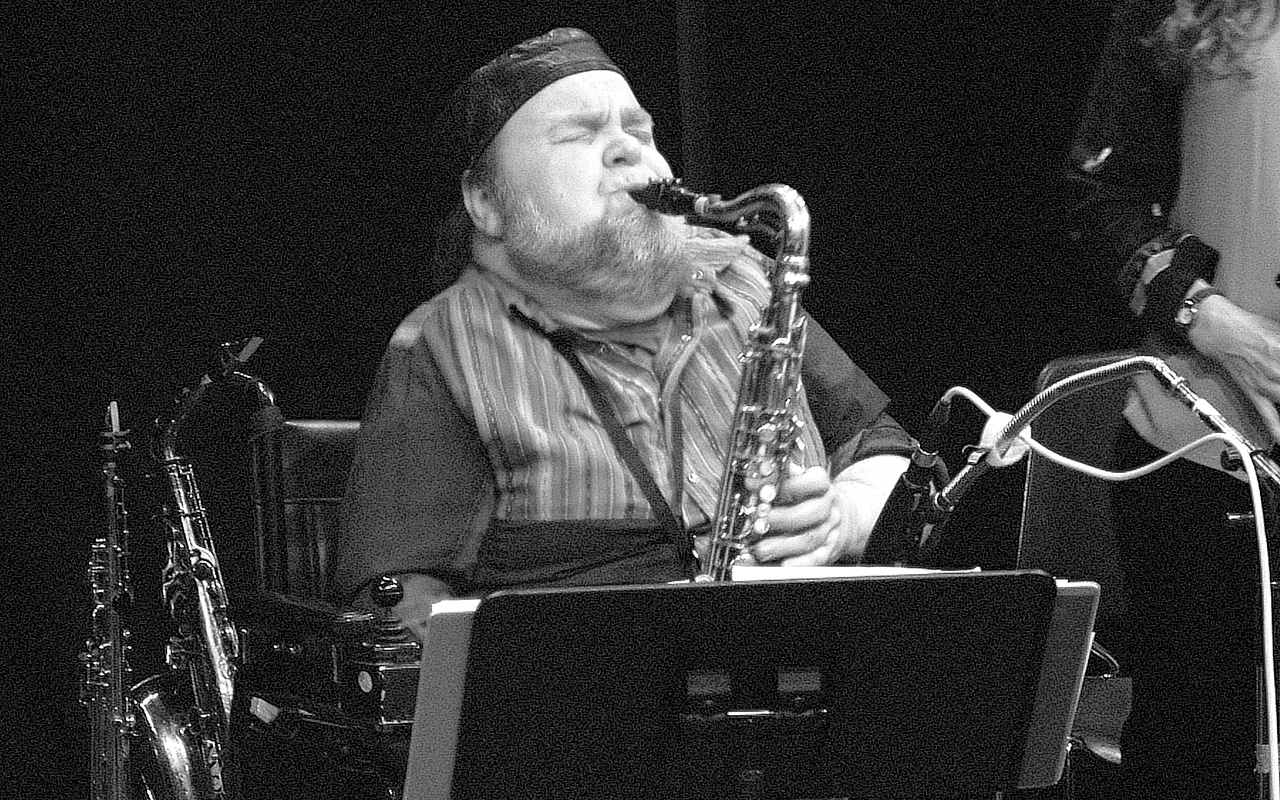
Bert Wilson Photo by Steve Cline
Bert Wilson, one of the region’s most celebrated jazz musicians, and one of the most distinctive saxophonists, anywhere, has died.
Wilson, a longtime resident of Olympia, passed away on June 6 at Providence St. Peter Hospital after a heart attack. He was 73.
In his early adulthood, Wilson lived and performed in Manhattan, which was particularly challenging when he lived in a sixth-floor apartment: He had been in a wheelchair since his childhood as a result of polio. He contracted the disease when four years old, at a time when it was prevalent in many countries.
Wilson won praise from devotees of vanguard jazz more than from those of the mainstream, but he turned his advanced saxophone technique and idiosyncratic abilities, in his discerning way, to produce jazz that was equally expressive whether fierce or sweet, full-on or subtle. Jazz writers noted his mastery of such techniques as multi-phonic double lines and harmonically integrated tone clusters. “He carried [Eric] Dolphy’s spirit into the future by being a bridge between ‘in’ and ‘out’ music and extending it through jazz and the immutable spirit,” John Ewing wrote in the June 2002 issue of Earshot Jazz [“The Immutable Spirit of Bert Wilson”]. Many other critics, and listeners, alike, noted Wilson’s way of turning even overblown and searing horn sounds to harmonic and melodic purposes.
Bert Wilson was born into a vaudeville family in Evansville, Indiana, in 1939. His grandfather introduced him to the music of Louis Armstrong, Duke Ellington and Benny Goodman. The family moved to Georgia when Bert was seven. While he was in a hospital with polio, a series of severe treatments did little to ease his physical misalignments, but did incidentally permit him movement in his shoulders, arms, neck and head, which allowed him to play first clarinet, and then sax.
When Wilson’s family relocated to Chicago, he was placed in the care of a children’s hospital school. There, when Wilson was 12, a fellow student introduced him to the bebop of Charlie Parker and others, which Wilson took to playing on clarinet. That strengthened his diaphragm, on one occasion saving his life from asphyxiation. His narrow escape convinced him that music would be his life.
He began mastering the tenor saxophone at Santa Monica City College after his family moved to California. He proved to possess prodigious talent, and began gigging around Los Angeles. At the famed Lighthouse venue, he worked with luminaries like trumpeter Barbara Donald and saxophonist Sonny Simmons; when Simmons and Donald married and moved to New York, Wilson followed.
He recorded with Simmons and James Zitro, and forged friendships with them and other regulars on the innovative, adventurous ESP recording label. But he faced daunting tasks, such as living in that sixth-floor apartment, which he could approach only with the assistance of friends who had to lift him to his building from the top of the one next door. After two years in New York, those severe daily difficulties led him to return to California.
In Berkeley, as in Manhattan, he attracted many jazz avant-gardists to play at his home, among them drummer Smiley Winters, David Wilson who led the NOW Creative Arts Jazz Ensemble, Rahim Roach and again Sonny Simmons.
Wilson moved to Los Angeles and then to Woodstock, New York, for a teaching gig at a center for free-jazz studies. Dissatisfied there, he moved to Olympia with the help of fellow musicians, particularly a friend from his Berkeley days, pianist Michael Moore.
In Washington State, he met his eventual wife, Nancy Curtis, a flutist with whom he lived for 30 years until his death. Numerous stand-outs on the Seattle and Puget Sound scenes found him in Olympia, and appeared on his numerous recordings. Northwest jazzers, like those in Wilson’s earlier locations, sought him out for his extraordinary abilities.
Ironically, the qualities that so distinguished Wilson’s playing positioned him on uncertain ground between bebop and the avant-garde where promoters were often hesitant to seek him out. Nonetheless, his reputation steadily grew; he was a saxophonists’ saxophonist, and one whom generations of Northwest jazz musicians embraced for his soaring, optimistic sound and affable company. Indeed, sax players came to Wilson for lessons from around the world. Among well-known recipients of his instruction and inspiration were Ernie Watts and Tower of Power’s Lenny Pickett.
Wilson’s appropriately named band, Rebirth, with Nancy Curtis and other regulars, consistently impressed. Fellow performers along with jazz writers sang Wilson’s praises as a key, albeit too-little-recognized, figure in jazz. He performed often at major Northwest jazz events, including the Earshot Jazz Festival. He had a weekly spot in Olympia with fellow tenor saxophonist Chuck Stentz. He had played his last gig just two days before he died.
Wilson was a larger-than-life figure, expansive in personality, as in his 60s-inspired wardrobe. In the Seattle Times, jazz columnist and Earshot co-founder Paul de Barros wrote that Bert was “a colorful, ebullient character who spoke in a gravelly voice in rhythmic cadences, calling men ‘brother’ and women ‘baby’ or ‘darlin.’ One of his favorite sayings was, ‘If you’re not groovin’ and swingin’, you’re not doin’ it right!’”